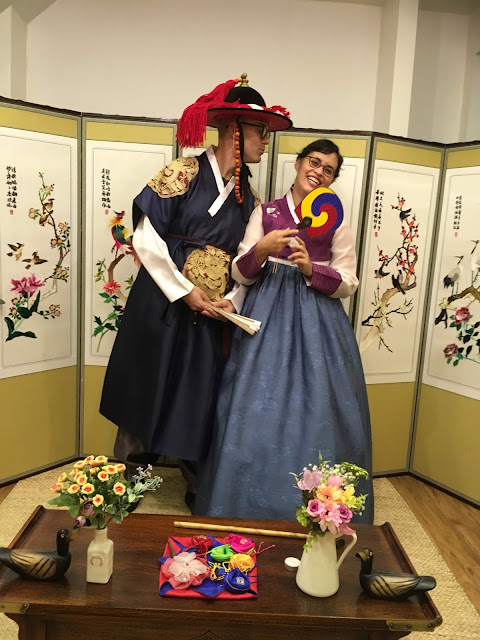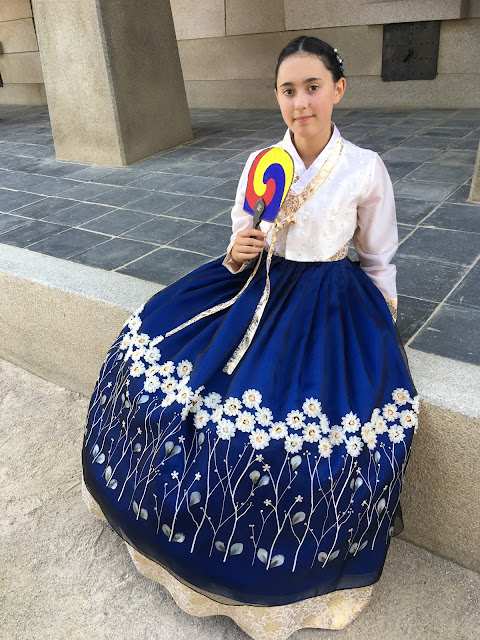by Holly
Last summer when I was in Korea I had heard that you could rent hanbok (traditional korean attire) to wear while touring around the main royal palace in Seoul, Gyeongbokgung. We like costumes and have seen plenty of hanbok in k-dramas, so we were excited to do this while in town.
I had some concerns about cultural appropriation and in general want to be sensitive about giving offense while being a guest in other parts of the world. I didn't research this particular thing too much, but at least the Koreans I have talked to about this activity did not seem to feel there was anything problematic about foreigners dressing up in traditional Korean clothes for a day while touring historic sights.
I think in general Koreans view it as a positive thing for foreigners to be interested in their country and culture. Historically, they have not usually had the luxury of choosing to be isolated and limiting contact with the outside world. Being sandwiched in a perilous part of the world and not as big and powerful as adjacent countries, Korea could not afford to ignore the outside. The outside world (Japan, China, the mongols, Americans, Russians, etc.) frequently demanded interaction whether or not anyone in Korea desired it to be so. In recent history, probably Koreans thought of their country as a smaller player than the giants around it. Maybe this contributes to Koreans feeling a little surprised but open when an outsider takes an interest in learning more about Korea.
In recent years, the worldwide wave of Korean cultural exports has drummed up tremendous interest in the country and culture from whence these products sprung. For instance in Malaysia, I've talked to people who say their teen kids have memorized so many k-pop songs even though they mostly don't know what the lyrics mean. A friend of a friend who grew up with Korean parents in the middle east says when she goes home lately there are tons of people in that country learning Korean and wanting to chat with her to practice. In Malaysia there are Korean stars on billboard ads, imported Korean snack foods at the supermarket, and Korean restaurants all over. In America this is true to a much smaller degree, but all the same I think there is a far higher level of awareness about Korean culture now than there was 10 or 20 years ago. My experience has been that Koreans feel like this is all a bit bizarre, but appreciate the fact that people are interested.
So anyhow, while in Seoul we stayed in an adorable new-build small house executed along the lines of a Hanok, a traditional Korean house.
It was just a short walk from the palace. We made a reservation at the 3355 Hanbok rental shop mainly because it was along our pedestrian route to the palace. We met up with our friends who were staying nearby and walked down to the shop at mid-day.
The two ladies in the shop helped us choose our clothes and get dressed, and we bought add-on hair service for the female members of our party.
Buster put up some resistance to getting dressed up, but at the end of the day he asked if we could buy his outfit to take home.
Child 1 was especially pleased with her outfit and hairdo.
Child 1 and I went on a guided tour of the palace for about an hour, but the weather was becoming hot even for those of us who have been living near the equator so the littler kids played in a shady grove near the big pond.
One of the coolest things about traditional Korean buildings is the underfloor heating. These builders were putting in radiant heat centuries before westerners even knew it existed! Fires are kept burning by feeding fuel in at small stone chambers in the foundation layer of the building and the exhaust runs under the floors, exiting on the far side of the building through chimneys. I'd love to learn more about how this was actually done; why didn't the smoke come out in the rooms? How often did these flues catch on fire? How was the draft started to keep air moving the right direction? What materials were used to contain and spread the heat in the floor? Below are some very nice masonry exhaust chimneys in the queen's garden which are the outlet for the heating system under the queen's chambers.
The brickwork, masonry, and tile roofing were exquisite all around the palace compound.
After the tour, Child 1 and I went to meet up with the rest of our group. We chilled out at the National Folk Museum for a while on the east side of the palace grounds.
After returning our costumes, we had a delicious dinner at a restaurant around the corner from the rental shop, then the little kids played on the grass on the grounds of a nearby art exhibition institute (which also had a few relocated historic palace buildings).















































